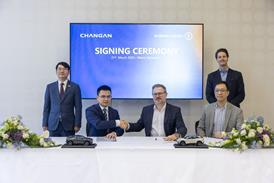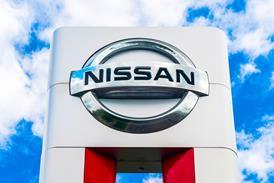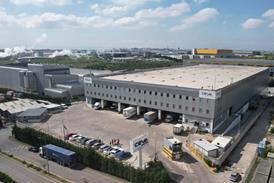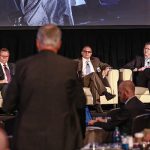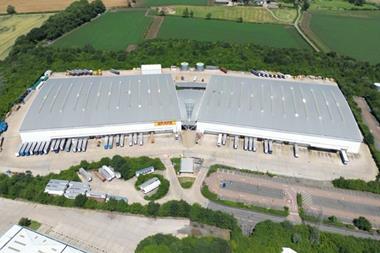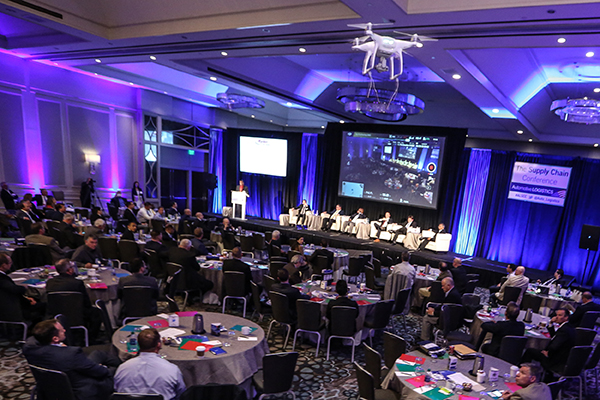
That the automotive industry will see [sta_anchor id="1"]exponential change is something that many, if not all, experts and executives predict – even if they disagree about the pace and scale of change. Technology developments such as autonomous vehicles, the rise of the ‘internet of things’ with more connected devices, and the growing shift towards alternatively-powered vehicles are all expected to transform products.
Social and economic shifts are also set to reshape many aspects of the sales and distribution market, including an increase in shared mobility and mobility services and shopping offered through connected cars.
That these developments will have major impacts on the automotive supply chain, including production and logistics, is also undisputed. Sensor-based parts and equipment will increase visibility and data; more advanced robotics, autonomous driving and machine learning will support new levels of automation and flexibility; predictive analytics could increase the accuracy of supply chain forecasting and planning.
A good example of the range of potential changes can be found in vehicle electrification. Sven Dharmani, principal for advisory services at consultancy EY, predicted a big drop in the cost of electric vehicles compared to internal combustion engines as charging infrastructure improved. “We could see a 50% reduction in the incremental costs of electric vehicles by 2025, compared to internal combustion engines,” he said.[in_this_story align="right" border="yes"]
Dharmani said the differences between the powertrain of electric vehicles and traditional cars would have a significant effect on logistics and the supply chain. Currently, combustion engines and transmissions consist of roughly 1,500 parts, compared with an electric motor of about 35 parts including the battery pack.
“So the logistics of how you put together the powertrain changes completely, and also where you get it from. Batteries are pretty heavy – you don't really want to ship them overseas,” Dharmani noted.
Jim Bydalek, vice-president of digital for automotive and aerospace at consultancy Capgemini, agreed that autonomous, electric vehicles could drastically change the entire nature of production, including not only the types and quantity of components but also modular plant designs and decentralised production control.
However, to achieve this connected future, Bydalek said agile and collaborative networks would be required. “That supply chain needs to be connected; there are no outsiders anymore.”
Scott Dewicki, leadership partner at Gartner, agreed that entire supply chains needed to be linked in the ways that they were not currently. “I don’t just mean procurement and sourcing, or materials management and logistics. I mean all of that. Supply chain is an [sta_anchor id="2"]integrated, end-to-end animal now,” he said.
 Benoit Montreuil, from Georgia Tech, pointed out that manufacturers spend very little on logistics and supply chain-related R&D
Benoit Montreuil, from Georgia Tech, pointed out that manufacturers spend very little on logistics and supply chain-related R&DWho is willing to lead in logistics?So it goes with fancy predictions and outlines of a vastly different supply chain and economy as part of so-called ‘industry 4.0’.
However, what is somewhat less clear is how the supply chain and logistics departments at manufacturers, along with their logistics providers, should respond – and whether they are doing enough to keep pace with the changes or to take advantage of innovations. Executives are clearly interested in exploring new technology, but manufacturers remain relatively cautious, with limited scope for risky investments.
Benoit Montreuil, leader of the Supply Chain and Logistics Institute at Georgia Tech University, suggested that there was not enough room to invest, trial or even fail at new ideas in automotive logistics. He pointed out that although carmakers invest enormous sums of money in research and development to design and engineer products, they spend very little on R&D that explores new ideas and approaches in supply chain and logistics.
“Few manufacturers would spend millions on testing a new supply chain concept. There is little room for innovation and failure in the automotive supply chain,” he said.
Live voting at the event confirmed this sentiment: 61% of respondents thought the automotive logistics industry was lagging behind other sectors in new technology developments.
Gartner’s Scott Dewicki suggested that even where carmakers and manufacturers were investing in new technology and processes to take advantage of advances in robotics or visibility, they were often done in isolation at individual plants or sites. Gartner predicts that by 2018, three out of five ‘internet of things’ projects will see benefits only at local plants – and thus fail to have a significant impact across wider supply chain networks.
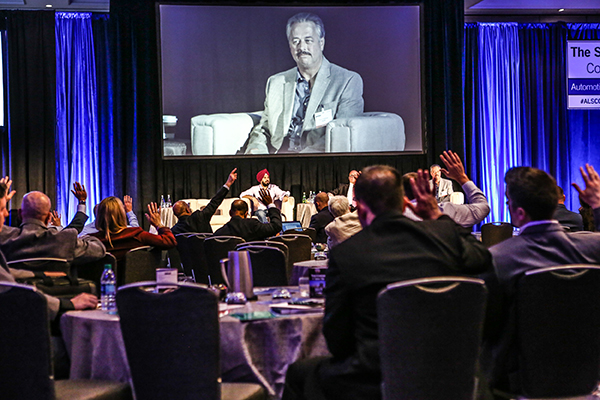 Honda's Dana McBrien (on screen) said it was time for OEMs to start making decisions on which logistics technologies they would commit to
Honda's Dana McBrien (on screen) said it was time for OEMs to start making decisions on which logistics technologies they would commit to“That is because it's hard to do, including hard to scale, hard to train and implement,” he said. “The data collected is fragmented and manual, and much of it goes unused.”
Dewicki said the real benefit would come when a company made those connections to the outside world, because it would then no longer be about the efficiency of a single plant.
Dana McBrien, who leads inbound logistics at Honda North America, admitted that it was often very difficult to push for change and adapt new technology within a large corporation like Honda – and that equally, innovative ideas from logistics firms or start-ups might not always survive committee decisions.
He added, however, that Honda had recognised the rapid pace of change in the industry and that it was time to act.
“We are probably at that fish-or-cut-bait juncture and it is time to redeploy and in some cases modify what we are doing. But in a lot of cases, it is time to look at new methodologies, new techniques, and new products – and really go after it wholesale,” McBrien added.
He also said collaboration with service providers was important and that Honda was even planning to launch small scale logistics collaboration projects with at least one other carmaker, which he declined to name.
William Wappler, president and chief executive of packaging and RFID specialist Surgere, warned that the automotive logistics industry could be resistant to change. However, he pointed to signs of progress: “I think the urgency for change is really taking place in the automotive industry.
“We had one very large client that literally built a war room with us, opened the door and said: ‘We trust you are going to get to the right solution. We are going to give you some team members. And when you come out of that door we are going to go and deploy it together’,” he reported.
Wappler also referred to the automotive industry’s mature manufacturing model as a challenge in its quest to adapt for industry 4.0, acknowledging that some companies were happy to be labelled ‘fast followers’, rather than innovators.[related_topics align="right" border="yes"]
Some executives at the event made it clear that this was the right approach for them, at least in logistics. Roberto Eggeling, director of logistics at Volkswagen Group of America, said he preferred an incremental approach to innovation to major overhauls. He pointed to countless efforts at the carmaker’s plant in Chattanooga, Tennessee, for example, where the company run trials and pilots of new logistics ideas.
“For me, innovation is making what we do better every day,” he commented.
Anu Goel, vice-president, group after sales and services, at Volkswagen Group of America, said that part of the lack of investment in new technology in the logistics division might be partly attributable to it being a cost centre, rather than a revenue generator, within a company.
Eggeling agreed, adding that decisions on investment in any technology in logistics would always come down to how much it could ultimately reduce costs.
“This is what we are looking for in logistics. For me, it is very simple: we are fighting for money and we are using tools which are being invented that we have to adapt to our needs.”[sta_anchor id="3"]
Montreuil challenged this thinking in the automotive industry, however, pointing to research models at Georgia Tech that suggested effective, agile and collaborative logistics networks could get products to market faster, beat competition and actually lead to increases in revenue.
Changing the map for logistics providersFor logistics providers, the changes in the industry present an array of dangers – but also potential opportunities.
Scott Perry, chief technology and procurement officer at Ryder, pointed out that e-commerce was already reshaping the retail distribution map across the US. This year will see thousands of stores close across the country, from bankrupt retailers like Payless Shoes to major national retailers like CVS Pharmacy, which has announced store closures following years of expansion.
Perry raised questions over the impact e-commerce would have on automotive dealerships and distribution networks, including a potential move to non-dealer deliveries and direct consumer orders. “We will have the same type of impacts in our sector, whether through drones or other technology that will lead to bigger changes to the distribution network,” he predicted.
Perry also pointed to new manufacturers that were emerging with complex logistics needs, including a host of start-up firms for alternatively powered vehicles.
 Ryder's Scott Perry pointed to new startups in logistics and in manufacturing did not necessarily care about historic relationships and networks in the automotive supply chain
Ryder's Scott Perry pointed to new startups in logistics and in manufacturing did not necessarily care about historic relationships and networks in the automotive supply chainExamples include hydrogen fuel-cell trucks by new entrant Nikola, as well as Tesla's all-electric tractor unit, which is expected to be revealed in September, according to Perry. Toyota, which traditionally hasn't manufactured in the large, Class 8 truck space, is set to trial a hydrogen-powered truck this summer at the port of Los Angeles.
Many of these companies, including Uber, are also developing autonomous trucks and commercial vehicles, which could disrupt fleet operations for logistics firms like Ryder, while also offering operating advantages.
“While I think it would be a long time before we see level five, fully autonomous vehicles in any sector, there is definitely an opportunity for heavy duty vehicles, that operate a significant amount of their time on highway, travelling long distances. They are prime candidates for automation,” Perry said.
He suggested that the most likely applications would be on a ramp-to-ramp or depot-to-depot basis, with local delivery or pedal-routes being manned but long stretches on the highway potentially being fully autonomous.
“That doesn't mean a driver sitting in the seat ready to take control of the steering wheel. It means a vehicle that is guided onto the entry ramp of the highway via remote control and put in autonomous mode for 300-400 miles (480-640km),” said Perry.
“This isn't ten years in the future. This is technology that is available today and regulations are rapidly advancing,” he added.
The startups are comingIt would be wrong to say that the automotive logistics industry has not already made good use of technology and advances in software. Kerry Zielinski, vice-president at logistics firm Syncreon and a 20-year veteran in third-party logistics, pointed out that when he started in the industry, analysts did logistics routing “using dots on a map, early spreadsheets like Lotus 1-2-3 and even hand-drawn driver route maps”.
Today, while there are still a fair number of spreadsheets and manual processes around, more companies have introduced sophisticated financial, algorithm and GPS tools to their logistics routing and network planning, helping to ensure cost-effective routes and consolidation, said Zielinksi.
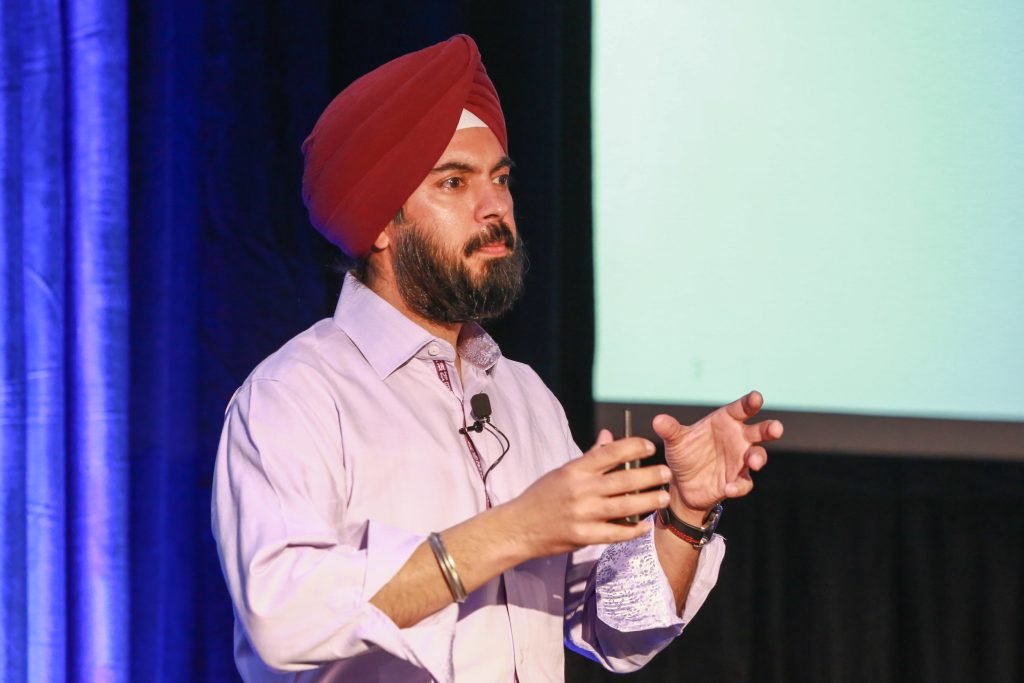 75F founded Deepinder Singh warned that startups were often like mice dancing with elephants when they tried to work with large corporation – at risk of getting stepped on
75F founded Deepinder Singh warned that startups were often like mice dancing with elephants when they tried to work with large corporation – at risk of getting stepped onHowever, there is also no doubt that a host of software and digital firms are targeting deeper inroads into the logistics industry. Scott Perry pointed to new players looking to develop algorithms and systems that could automate and simplify even more parts of the shipping process. He said the US technology hub saw the automotive industry as a “veritable playground”.
“They are looking at it as a smorgasbord of opportunity for disruption and how they can deploy new technology,” he told delegates.
While there was considerable room for collaboration between 3PLs and these new companies, Perry also warned that startups had little consideration for the long-established networks, processes and business relationships that companies like Ryder had formed with industrial customers over the past 30 years or so.
“There is no real consideration for how business is conducted, how relationships exist,” he said. “The focus is on how they can accelerate efficiency and innovation and eliminate inefficiency, doing so by connecting as many partners in the industry as possible.”
Perry’s colleague at Ryder, Mel Kirk, who is senior vice-president and chief information officer, warned that these types of disruption were much more fundamental to the nature of logistics and supply chain than many changes that came before.
He gave the example of Walmart requiring new, larger sizes of cereal boxes when he worked at General Mills, which required new packaging and dimensions in distribution centres. “But this change – as we see with Amazon with e-commerce or with digital disruption – is much more fundamental,” he said.
However, while they may threaten some parts of the 3PL model, it is not an easy road for digital startups in the automotive logistics industry. From many new companies’ or entrepreneurs’ points of view, the prospect of working with a large-scale corporation like that of a carmaker can be daunting.
“It’s as if you are a mouse dancing with a pink elephant. If the elephant steps on the mouse, they don’t even realise it,” said Deepinder Singh, chief executive and founder of climate control and energy efficiency start-up 75F, whose sensor-controlled devices are used in building construction.
“You want to start with a company that is more fitting your size. It always seems very attractive to work with a [large company] from day one, but they will eat you alive and they won’t even notice,” he said. “You first want to figure out your market space and truly figure out whether the disruption is working before you want to scale it out.”
Any projects with larger companies need to be executed in steps, he advised.
“You need to put in a staggered schedule and say this is what both parties think is realistic,” said Singh. “It is also something that as a [sta_anchor id="4"]startup, you can take back to whoever is funding you. Because you can show that you have this agreement with very clear and defined goals.”
Subaru catches up with digitalisationThe conference also offered examples of carmakers and logistics providers making progress in adapting to market changes and various kinds of software and technology.
Subaru of Indiana, for example, has aggressively implemented new systems and processes in tandem with logistics specialist Venture Global Solutions, as the plant recently ramped up production.
The project has helped Subaru catch up in areas of digitalisation, including moving from manual, spreadsheet-based planning processes for logistics to adopting a new transport management system (TMS) and a new yard management system (YMS) that will eventually introduce highly advanced RFID and drone technology.
The improved planning processes also helped Subaru redesign its inbound logistics network, including adding a number of new lean separation centres (crossdocks) to improve parts consolidation and the sorting of parts, according to Darryl Bol, section manager material management logistics.
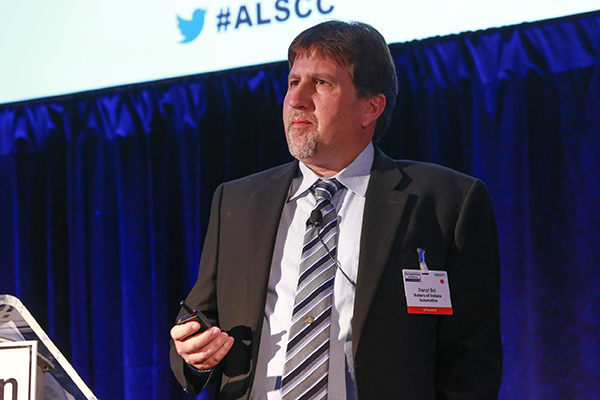 Darryl Bol said that Subaru had reduced inventory at its Indiana plant from 1.25 days to 4.5 hours
Darryl Bol said that Subaru had reduced inventory at its Indiana plant from 1.25 days to 4.5 hoursNow, every part that arrives at Subaru’s plant goes to a designated dock and can move directly to its consumption point in the plant, rather than requiring further sorting.
In undertaking this project, Subaru increased visibility and flexibility, while reducing transport miles, inventory and costs. It did that at the same time as adding a new assembly line, a new model and roughly doubled production from 850 cars per day to 1,600 by October 2016.
“Back in 2015 is where we started. We weren’t hooked up with Venture Global yet; we weren’t prepared for the optimisation. We were using spreadsheets and maps to set up our routing,” said Bol.
He added that the plant operated mixed production (producing multiple models on single lines) as well as bridged production (one model on two separate lines). Daily volume is expected to increase further to level off at about 1,800 vehicles a day from next year.
As part of the expansion, the company added a second paint shop alongside the additional capacity for its assembly lines. As a result, a significant portion of warehouse space within the plant was converted to production space.
“We knew from an inventory policy we were going to go from 1.25 days of standard inventory down to 4.5 hours,” says Bol. “We wanted very high-frequency, low-volume inventory coming into our system.”
In April this year, the company started its new YMS with Venture, allowing it to track and trace everything inside and outside the yard.
“This digital yard is real-time, it is data-driven, automated and integrated. We use software to eliminate the islands of information,” Bol said.
The company is also planning on rolling out the use of drones to track inventory in the yard that will register inventory using RFID scans. [sta_anchor id="5"]Bol said the drones would even be able to fly to other nearby logistics centres to check inventory in those locations.
E-commerce changes aftermarket mindsetsNot all progress is fully based on pure technology advances or investments – some is simply about changing processes.
Neil Swartz, vice-president and general manager for Toyota’s service parts division in North America, admitted that his company was generally cautious to change and adding new technology to processes. “There is often a lot of momentum for the status quo,” he said.
However, for service parts logistics, the carmaker is reacting to the changes in the marketplace. Swartz said the carmaker was increasingly interested in automation in its warehouses, particularly for the conveyance of parts and packaging, which represent 50-60% of processes. “We see a lot of low-hanging fruit for automation,” he said.
Recognising demands from customers for faster, more flexible service, Toyota, along with other brands, has been investing further in serving those needs, even where it requires higher logistics costs. For example, a large share of its network now offers same-day delivery service to dealers. To support such deliveries, the carmaker has opened new distribution centres in the southeast of the US to improve service to Lexus dealers, for example.
Swartz admitted that Toyota had followed the lead of BMW on same-day service, which has set up a number of facilities in major metropolitan areas that allow for delivery three times per day. John Goione, department head for parts logistics at BMW North America, said the carmaker now hit 50% of its car parc with the same-day delivery. “It is quite powerful. It is a service offering more than a parts offering,” he said.
In the next step, BMW may look to introduce some slower-moving parts into these distribution hubs to allow for faster delivery of these, too.
Swartz pointed to the potential of one day using vehicle data to enhance customer service, including the use of proactive monitoring and diagnostics to aid just-in-time parts delivery and service scheduling.
BMW is also taking advantage of the telematics systems in its vehicles by gathering more data. “We have a strong telematics backbone [sta_anchor id="6"]and now we are really starting to get actionable data via it that we can build into applications and integrate into service,” Goione said.
 Cooper Standard's Mike Silvio encouraged companies to nurture the creativity of millennial employees, but still give them strong guidance on business processes
Cooper Standard's Mike Silvio encouraged companies to nurture the creativity of millennial employees, but still give them strong guidance on business processesChanging the culture of a workforceThe future, though not without risk, is full of promise for the supply chain. The phasing-in of mandatory requirements to use electronic driver logs in trucks, for example, is leading providers to use new systems for tracking driver behaviour and processes. There is also more focus on reducing truck emissions and fuel costs with new technology. Drones and wearable devices offer further opportunities to improve cost and performance.
The wheel is even being reinvented, it seems. At Pirelli Tire North America, John Godfrey, vice-president of logistics for Nafta, pointed to advances including ‘connected‘ tyres that will communicate data about usage, wear and replacement to car owners, and could also help Pirelli plan production and supply for the aftermarket. The tyremaker is also introducing further automation for materials handling in its plants.
Speakers nevertheless raised many questions over how the industry should adapt, invest, and train and educate its workforce for this new era. New standards would need to be adapted, while companies would have to work hard to remove barriers between legacy IT systems, new software and their supply chain, said Gartner’s Scott Dewicki.
He also advised firms to challenge their “mavericks, millennials and renegades”.
“Find the square pegs who just don’t want to be tied down to site-level, operational metrics. They want to change the world, they want to be dreamers,” he advised.
Mike Silvio, senior director supply chain management at tier one supplier Cooper Standard, also warned firms they needed to take extra care in nurturing millennials, including offering clear paths of development, working flexibility, continuous learning and managers that coach.
He added, however, that companies also needed to ensure this breed of young professionals understood business processes and data management.
“They just don’t have the experience yet. You can’t be effective and apply these new ideas until you understand the businesses processes,” said Silvio.
At the same time, youthful energy and excitement needs to be harnessed across the sector. “I am disappointed when I see their leaders not foster that excitement or energy.”
Attracting innovative talent into the industry is also a challenge that needs to be addressed according to Surgere’s Wappler.
“How do we build an organisation that will embrace outside innovators and then help make change happen? It is a critical skill that we all need to have,” he said.
 Ryder's Mel Kirk suggested that companies too often let their people fall behind rather than focusing simultaneously on staff, technology and processes
Ryder's Mel Kirk suggested that companies too often let their people fall behind rather than focusing simultaneously on staff, technology and processesRyder’s Mel Kirk also highlighted the importance of educating and training existing workers for digital disruption. “The industry needs to have a discussion on talent,” he suggested, emphasising that succeeding in a changing industry would not be purely about technology.
“People, process and technology. The merging of those three things to create an efficient and effective system is what you are striving for,” he said. “And the piece of the puzzle that I think all of us are continuing to leave behind, or to discount, is the people part.”
Kirk stressed that companies, universities and other education providers needed to work together to make sure they were preparing future staff with the right foundation and training to face the new realities of supply chain and logistics.
“We have got to retool. It is probably one of the least discussed pieces and I think it is a critical part of the journey that all of us are on,” said Kirk.
Capgemini’s Bydalek reminded companies not to forget the cultural impact when attempting to align their digital strategy with their business strategy, meanwhile.
“You have to go into this knowing that it is an organisational change that is taking place and your culture is going to change,” he said.
To view videos from the conference, click here.
Automotive Logistics Supply Chain Conference is part of the global Automotive Logistics series of conferences
The next conference is the Automotive Logistics Europe in Bonn, Germany on June 6-8th.
The next conferences in North America will be Finished Vehicle Logistics Import/Export North America in Baltimore, Maryland on August 9th, followed by Automotive Logistics Global on September 19-21st.
Topics
- BMW
- Cooper Standard
- Digitalisation
- features
- Honda
- Inbound Logistics
- Inventory management
- Lotus
- North America
- Packaging
- Pirelli
- Plant Logistics
- Policy and regulation
- Ryder
- Ryder
- Service Part Logistics
- Start-ups
- Subaru
- Suppliers
- Supply Chain Planning
- Surgere
- Syncreon
- Telematics
- Toyota
- Track-and-trace
- United States Of America
- UPS
- Venture
- Volkswagen Group
















